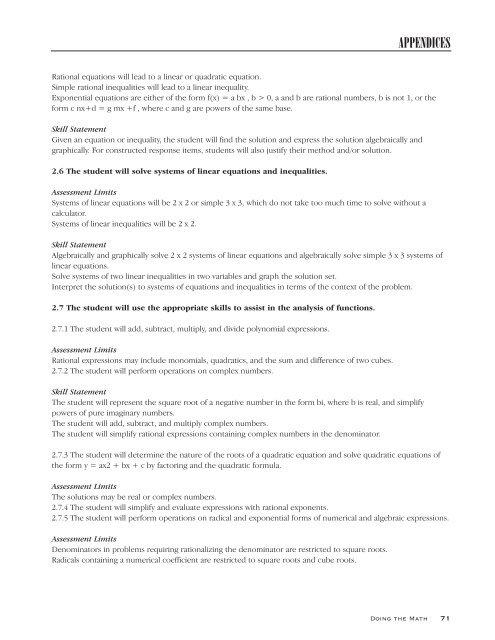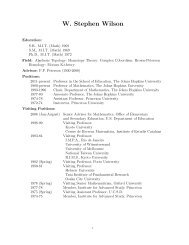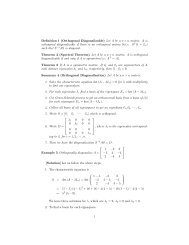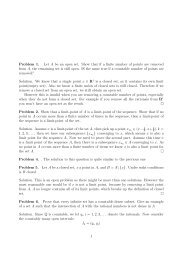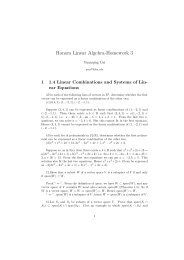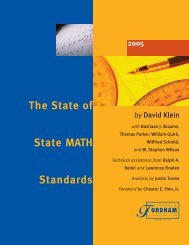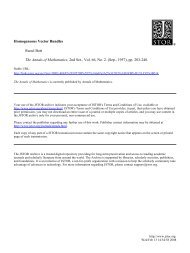Doing the Math - JHU Mathematics - Johns Hopkins University
Doing the Math - JHU Mathematics - Johns Hopkins University
Doing the Math - JHU Mathematics - Johns Hopkins University
You also want an ePaper? Increase the reach of your titles
YUMPU automatically turns print PDFs into web optimized ePapers that Google loves.
APPENDICES<br />
Rational equations will lead to a linear or quadratic equation.<br />
Simple rational inequalities will lead to a linear inequality.<br />
Exponential equations are ei<strong>the</strong>r of <strong>the</strong> form f(x) = a bx , b > 0, a and b are rational numbers, b is not 1, or <strong>the</strong><br />
form c nx+d = g mx +f , where c and g are powers of <strong>the</strong> same base.<br />
Skill Statement<br />
Given an equation or inequality, <strong>the</strong> student will find <strong>the</strong> solution and express <strong>the</strong> solution algebraically and<br />
graphically. For constructed response items, students will also justify <strong>the</strong>ir method and/or solution.<br />
2.6 The student will solve systems of linear equations and inequalities.<br />
Assessment Limits<br />
Systems of linear equations will be 2 x 2 or simple 3 x 3, which do not take too much time to solve without a<br />
calculator.<br />
Systems of linear inequalities will be 2 x 2.<br />
Skill Statement<br />
Algebraically and graphically solve 2 x 2 systems of linear equations and algebraically solve simple 3 x 3 systems of<br />
linear equations.<br />
Solve systems of two linear inequalities in two variables and graph <strong>the</strong> solution set.<br />
Interpret <strong>the</strong> solution(s) to systems of equations and inequalities in terms of <strong>the</strong> context of <strong>the</strong> problem.<br />
2.7 The student will use <strong>the</strong> appropriate skills to assist in <strong>the</strong> analysis of functions.<br />
2.7.1 The student will add, subtract, multiply, and divide polynomial expressions.<br />
Assessment Limits<br />
Rational expressions may include monomials, quadratics, and <strong>the</strong> sum and difference of two cubes.<br />
2.7.2 The student will perform operations on complex numbers.<br />
Skill Statement<br />
The student will represent <strong>the</strong> square root of a negative number in <strong>the</strong> form bi, where b is real, and simplify<br />
powers of pure imaginary numbers.<br />
The student will add, subtract, and multiply complex numbers.<br />
The student will simplify rational expressions containing complex numbers in <strong>the</strong> denominator.<br />
2.7.3 The student will determine <strong>the</strong> nature of <strong>the</strong> roots of a quadratic equation and solve quadratic equations of<br />
<strong>the</strong> form y = ax2 + bx + c by factoring and <strong>the</strong> quadratic formula.<br />
Assessment Limits<br />
The solutions may be real or complex numbers.<br />
2.7.4 The student will simplify and evaluate expressions with rational exponents.<br />
2.7.5 The student will perform operations on radical and exponential forms of numerical and algebraic expressions.<br />
Assessment Limits<br />
Denominators in problems requiring rationalizing <strong>the</strong> denominator are restricted to square roots.<br />
Radicals containing a numerical coefficient are restricted to square roots and cube roots.<br />
<strong>Doing</strong> <strong>the</strong> <strong>Math</strong> 71


